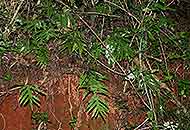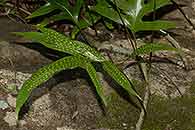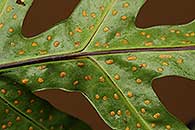Microsorum scolopendria (Burm. f.) Copel.
Synonyms |
Phymatodes scolopendria (Burm. f.) Ching |
|---|---|
Common name |
|
Description |
Rhizome widely creeping, up to 1 cm in diameter; rhizome scales up to 4 mm long, dark brown, (narrowly) lanceolate in outline, apex tapering to a point, finely toothed, later lost and surface becoming white. Fronds widely spaced, coriaceous, glabrous. Stipe up to 45 cm long, stramineous to light brown, glabrous. Lamina up to 60 × 30 cm, deltate-ovate to broadly oblong in outline, deeply pinnatifid into 4-8 pairs of lobes and a terminal segment. Lobes up to 22 × 3 cm, narrower in fertile than in sterile fronds, narrowly oblong to linear in outline, apex pointed, margins entire to somewhat wavy, glabrous. Sori round to oval, 2-3 mm in diameter, in 1-2 regular to irregular lines on either side of the costae, slightly sunken into the lamina, prominent on the upper side, exindusiate, with nonpeltate paraphyses. |
Notes | |
Derivation | skolopendrion: a millipede; a comparison alluding to the creeping rhizome with its rootlets. |
Habitat | Evergreen forest and thicket, Brachystegia woodland, mangrove swamps edges, limestone cliffs, oil palms, mango, clove trees and Pandanus. |
Distribution worldwide | Africa, Comoro and Mascarene islands, Madagascar, Seychelles, Sri Lanka, southeastern Asia, Indo-China, Malaysia to Australia and Polynesia. |
Distribution in Africa |
Angola, Benin, Cameroon, Central African Republic, Dem. Republic of Congo, Equatorial Guinea (incl. Bioko), Ethiopia, Gabon, Ghana, Guinea, Ivory Coast, Kenya, Liberia, Mozambique, Nigeria, Rwanda, Sierra Leone, South Africa, Sudan and South Sudan, Tanzania , Togo, Uganda, Zimbabwe. |
Growth form |
Epiphytic, lithophytic, terrestrial. |
Literature |
|





